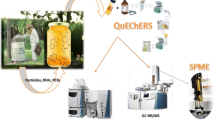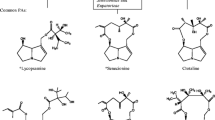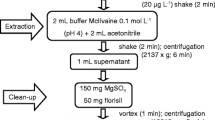Abstract
The present work describes the development and validation of an analytical method based on liquid chromatography (LC), coupled with tandem mass spectrometry (MS/MS) that allows the determination and confirmation of several endocrine-disrupting chemicals (EDCs) in honey. The EDCs studied were nine phenols of different nature: chlorophenols (2,4-dichlorophenol, 2,4,5-trichlorophenol, and pentachlorophenol), alkylphenols (4-tert-butylphenol, 4-tert-octylphenol, and 4-n-octylphenol) bisphenols (bisphenol-A and bisphenol-F), and 4-tert-butylbenzoic acid. The method incorporates a restricted-access material (RAM), coupled on-line to the LC-MS/MS system, which allows direct injection of the matrix into the RAM-LC-MS/MS system. The optimized method developed, RAM-LC-MS/MS, was applied to fortified honey samples, affording detection limits in the 0.6–7.2 ng g−1 range, calculated for a signal-to-noise ratio of 3. In addition, the method was validated as a quantitative confirmatory method according to European Union Decision 2002/657/EC. The validation criteria evaluated were linearity, repeatability, reproducibility, recovery, decision limits, detection capabilities, specificity, and ruggedness. Repeatability and within-laboratory reproducibility were evaluated at two concentration levels, being ±11% or below at 20 ng g−1. The decision limits (CCα) and detection capabilities (CCβ) were in the 1.7–12.6 and 2.8–21.6 ng g−1 range, respectively.




Similar content being viewed by others
References
Anklam E (1998) Food Chem 63:549–562
Fernández M, Picó Y, Mañes J (2002) J Food Prot 65:1502–1511
Tahboub YR, Zaater MF, Barri TA (2006) Anal Chim Acta 558:62–68
Pang GF, Cao YZ, Fan CL, Zhang JJ, Li XM, Li ZY, Jia GQ (2003) Anal Bioanal Chem 376:534–541
Nozal MJ, Bernal JL, Martín MT, Jiménez JJ, Bernal J, Higes M (2006) J Chromatogr A 1116:102–108
Herrero-Hernández E, Carabias-Martínez R, Rodríguez-Gonzalo E (2009) Anal Chim Acta 650:195–201
Campillo N, Peñalver R, Aguinaga N, Hernández-Córdoba M (2006) Anal Chim Acta 562:9–15
Bogialli S, Di Corchia A (2007) J Biochem Biophys Methods 70:163–179
Rissato SR, Galhiane MS, Knoll FRN, Apon BM (2004) J Chromatogr A 1048:153–159
Tadeo JL, Sánchez-Brunete C, Albero B, García-Valcárcel AI (2009) J Chromatogr A. doi:10.1016/j.chroma.2009.11.066
Korta E, Bakkali A, Berrueta LA, Gallo B, Vicente F (2002) J Food Prot 65:161–166
Desilets CP, Rounds MA, Regnier FE (1991) J Chromatogr 544:25–39
Souverain S, Rudaz S, Veuthey JL (2004) J Chromatogr B 801:141–156
Sadílek P, Satínsky D, Solich P (2007) Trends Anal Chem 26:375–384
Lopez de Alda MJ, Díaz-Cruz S, Petrovic M, Barceló D (2003) J Chromatogr A 1000:503–526
Chico J, Meca S, Companyó R, Prat MD, Granados M (2008) J Chromatogr A 1181:1–8
Li D, Oh JR, Park J (2003) J Chromatogr A 1012:207–214
Basheer C, Lee HK (2004) J Chromatogr A 1057:163–169
Muncke J (2009) Sci Total Environ 407:4549–4559
Kuo HW, Ding WH (2003) J Chromatogr A 1027:67–74
Ballesteros-Gómez A, Rubio S, Pérez-Bendito D (2009) J Chromatogr A 1216:449–469
Nerín C, Philo MR, Salafranca J, Castle L (2002) J Chromatogr A 963:375–380
Shao B, Han H, Li D, Ma Y, Tu X, Wu Y (2007) Food Chem 105:1236–1241
Shao B, Han H, Tu X, Huang L (2007) J Chromatogr B 850:412–416
Campillo N, Peñalver R, Hernández-Córdoba M (2006) J Chromatogr A 1125:31–37
Inoue K, Murayama S, Takeba K, Yoshimura Y, Nakazawa H (2003) J Food Compos Anal 16:497–506
Rodríguez-Gonzalo E, García-Gómez D, Carabias-Martínez R (2009) J Chromatogr A 1217:40–48
2002/657/EC: Commission Decision. Official Journal of the European Union L 221, 17.8.2002
Kostiainen R, Kauppila TJ (2009) J Chromatogr A 1126:685–699
Liu M, Yan W, Lin JM, Hashi Y, Liu LB, Wei Y (2008) J Chromatogr A 1198–9:87–94
Feitosa-Felizzola J, Temine B, Chiron S (2007) J Chromatogr A 1164:95–104
Acknowledgments
The Ministerio de Ciencia e Innovación, Spain, (Project CTQ 2008-02200/BQU) and Junta de Castilla y León (Grupo de Excelencia GR-65) are gratefully acknowledged for financial support of this work. Diego García-Gómez gratefully acknowledges financial assistance from a Formación de Profesorado Universitario (FPU) grant of the Ministerio de Educación. The authors thank Dr. C. Raposo (Servicio General de Espectrometría de Masas, Universidad de Salamanca) for assessment and technical support.
Author information
Authors and Affiliations
Corresponding author
Rights and permissions
About this article
Cite this article
Rodríguez-Gonzalo, E., García-Gómez, D. & Carabias-Martínez, R. A confirmatory method for the determination of phenolic endocrine disruptors in honey using restricted-access material–liquid chromatography–tandem mass spectrometry. Anal Bioanal Chem 398, 1239–1247 (2010). https://doi.org/10.1007/s00216-010-3621-z
Received:
Revised:
Accepted:
Published:
Issue Date:
DOI: https://doi.org/10.1007/s00216-010-3621-z




